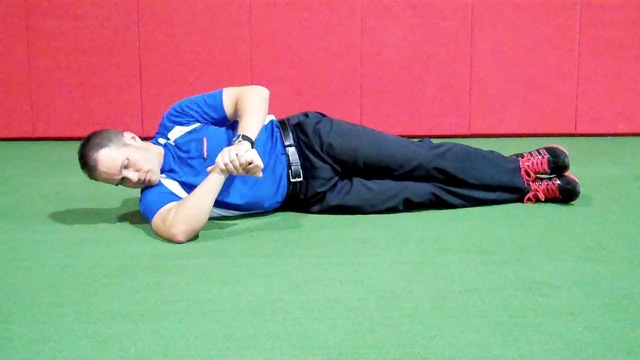
In the latest edition of Functionally Fit, Brian focuses on shoulder impingement, demonstrating an exercise to specifically address posterior shoulder tightness.
Shoulder impingement and rotator cuff tendonitis are a commonproblem for many clients. While there are certain anatomical considerationsthat the trainer cannot know or impact (shape of acromion, bone spurs or narrowsupraspinatus outlet, to name a few), there are certain preventive measuresfitness professionals can implement to reduce the incidence of shoulder pain. Today'sexercise specifically addresses posterior shoulder tightness.
Execution:

Begin in a side lying position (on the affected or stretch side) to stabilize the scapula. Next, position the arm at 90 degrees of shoulder flexion. Position the other forearm above the stretch arm to ensure the humerus does not go into external rotation. Next, grasp the elbow and pull the arm up away from the floor and across the body.
 |  |
Pull until a strong but comfortable stretch is felt and hold30 seconds. Repeat two to three times. You may opt to add more internalrotation and stretch in less than 90 degrees of abduction to vary the stretchfelt in the posterior shoulder as well.
It is important to recognize that the stretching should notevoke pain. However, many clients will find it awkward and perhapsuncomfortable at first. Another common stretch that is employed is the sleeperstretch:
 |
Application:
It is common for people (especiallythrowers and overhead athletes) to have posterior shoulder tightness. This is problematicbecause it can lead to abnormal glenohumeral joint mechanics and impingement. Withrepetitive movement and stress, clients can suffer permanent change in thetendons (tendonosis) or even go on to suffer a rotator cuff tear.
Applying soft tissue mobilization techniques and routineposterior shoulder stretching for the "at risk" population or thosewith a history of shoulder pain often resolves their symptoms in a short timeand promotes more congruent shoulder motion and biomechanics.
I would caution you about using this stretch too soon oraggressively with those suffering more acute symptoms as it may actuallyirritate them until the initial inflammation has subsided. I find this to beparticularly true in the sleeper stretch. One other cautionary note is thatclients with moderate AC joint arthritis may experience soreness with thehorizontal adduction (pulling) motion so be aware of that too.
Brian Schiff, PT, CSCS, is a licensed physical therapist,respected author and fitness professional. Currently, he serves as thesupervisor at the Athletic Performance Center in Raleigh, NC. Brian presentsnationally at several professional conferences and seminars on injuryprevention, rehab and sport-specific training. For more cutting edge traininginformation, subscribe to his monthly Training & Sports Medicine Update at www.BrianSchiff.com.

















